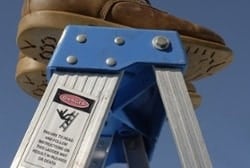Ladder Safety Tips from Moffitt
Ladders are essential for many of our daily tasks in homes, offices, and work sites. Because ladders are so common people assume that they know how to use them properly. As workplace safety is a top priority for most industrial companies is it crucial that every employee knows and follows ladder safety tips.
But always remember that safety is important in any job. But more so for jobs that involve having to work at a height or using large machinery. Therefore, courses are being held, to make safety the top priority of every worker.
When you work as part of a team, the safety of everyone you work with is important. Therefore, first aid training is a requirement for staff. You never know what can happen, but it is best to be prepared, so you can deal with any situation you have to face. According to OSHA the primary cause of injuries involving ladders is people using them improperly.
In the workplace, OSHA statistics show that each year there are 36-fatalities and nearly 25,000 recordable injuries involving ladders. In the home, The US Product Safety Commission estimates there are 164,000 ladder-related injuries that result in a trip to the emergency room. From step stools to extension ladders, using ladders is such a common activity that it is easy to forget that a ladder is a tool with inherent risk and associated hazards. The first step in using these ladders safely tips and being aware of the risks.
Top 3 Ladder Safety Tips.
- Always face the ladder.
- Always maintain 3-points of contact and keep your body positioned within the rails.
- Do not carry items with you as you climb the ladder
Top 4 Most Common Causes For Ladder Incidents:
- Using a ladder improperly or not using the correct ladder for your task.
- Attempting to work from a ladder or carry objects while climbing a ladder.
- Not thoroughly inspecting a ladder before using it.
- Electrocution
Injuries involving ladders happen because the people are working much higher than an average ladder, right? Not true. Height is not the deciding factor by far. Unfortunately, there are many cases that involve permanent injury, paralysis, and even death resulting from falls less than 6′, and from as little as falling from the first rung of a ladder. The most common injury sustained involving a ladder is a fracture involving legs or arms, followed by head and neck injuries.
No one plans to fall. Most of us have thought about what we would do if we did fall, and normally we all think that we will react and be able to grab something or catch ourselves. But the reality is that an average person’s reaction time is half a second. In that half of a second, you will have already fallen 4 feet. Still think you can catch yourself? Don’t count on it.
Basic Ladder Safety Tips
There are many types of ladders manufactured from different materials with different ratings. The most common are aluminum or fiberglass step ladders and extension ladders. When choosing a ladder, plan your task and make sure you pick the correct type of ladder and height for what you are planning to do.
Finally, before using a ladder always inspect it to make sure all the parts are in good condition. Make sure everything works and that there is no damage.
When setting up your ladder consider the following:
- Is this the right ladder for my task?
- Have I inspected the ladder?
- Is the surface stable that the ladder will be on?
- Is there traffic in the area, either human or vehicles?
- Have I checked to see if my ladder is secure?
- Do I need a spotter?
Extra Ladder Safety Tips
- Do not climb a ladder if you feel tired or dizzy.
- Always use a ladder as specified by the manufacturer.
- Plan your task and choose the right ladder.
- Always inspect the ladder before using it and check the weight rating. Remember to account for your tools when thinking about the weight.
- Make sure the ladder is stable before beginning to climb it.
- Always maintain 3-points of contact and do not carry items as you climb the ladder.
- Never overreach to the side of a ladder and always maintain your balance.

